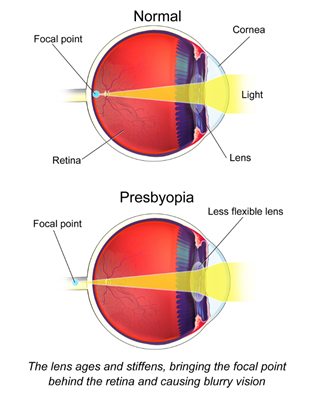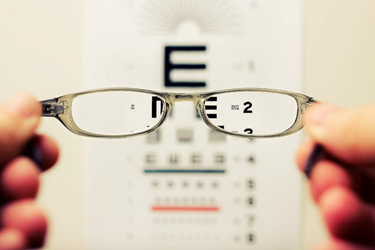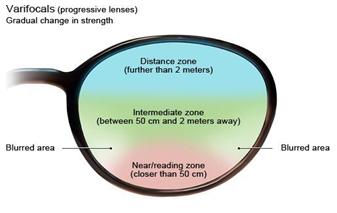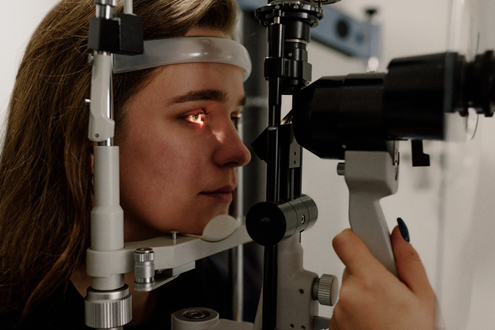What is presbyopia?
Presbyopia is a type of refractive error that is caused by changes in the lens of the eye as a result of the natural ageing process. Those with presbyopia gradually lose their ability to focus on nearby objects, such as reading a text message or reading a book, but in most cases their ability to see faraway objects remains intact. Most people will notice the effects of presbyopia sometime after the age of 40 years.
The following sections will briefly outline the public health implications of presbyopia, what causes presbyopia, its signs and symptoms, and some insights into its management strategies.

How many people suffer from presbyopia?
Based on an estimate by Australian researchers in 2015, approximately 1.8 billion people suffer from presbyopia worldwide. This number is projected to increase to around 2.1 billion by 2030 [1].
Presbyopia is known to develop with age and typically starts to develop in adults at around 40 years of age. It affects people in both developed and developing countries. In the United States, the proportion of people aged 45 years and above with presbyopia was found to be 88.9% [2]. Similarly, in developing countries such as Brazil, the proportion of adults 45 years and above with presbyopia was found to be 76% [2].
Uncorrected presbyopia is one of the leading causes of vision loss in the world and predominantly affects low- and middle-income countries [3]. In these countries, the proportion of people with their presbyopia corrected can be as low as only 10%. If left uncorrected, presbyopia may lead to increased difficulty when carrying out daily near work activities and an overall reduction in quality of life due to loss of clear vision [2].
The economic costs of presbyopia
Presbyopia also poses major economic problems due to its high direct and indirect medical costs, as well as productivity losses associated with the condition. A study conducted in 2011 estimated a global productivity loss of US$ 25.4 billion each year due to uncorrected and under-corrected presbyopia [2].

Figure 1. Diagram showing the difference between an eye without presbyopia and an eye with presbyopia. (Source: https://en.wikipedia.org/wiki/Presbyopia)
How does presbyopia develop?
During the natural process of ageing, the lens of the eyes become harder and less flexible. Ciliary muscles in the eye also become weaker with age. The ciliary muscles are a ring of smooth muscle in the eye that helps control the shape of the lens when focusing on nearby and distant objects. The hardening of the lens and the weakening of the ciliary muscles in people with presbyopia make it difficult for the lens to focus light properly onto the retina to produce clear vision. Instead, light gets focused behind the retina, which causes blurry vision when looking at nearby objects.
Is presbyopia the same as far-sightedness?
Even though presbyopia is often described as age-related far-sightedness, it should not be confused with far-sightedness (hypermetropia). Hypermetropia is a refractive error that can develop in both children and adults. It is caused by a shortened eyeball, which causes light to focus behind the retina and results in the eye not being able to focus properly on nearby objects. It is possible to have both hypermetropia and presbyopia that develops with age. People with near-sightedness (myopia) can also experience presbyopia which develops later with age.
What causes presbyopia?

There are several causes of presbyopia, which include:
The natural process of ageing
A person’s age is one of the main causes of presbyopia as it is known to develop gradually with the natural process of ageing.
Medical conditions
People with certain medical conditions are known to have presbyopia at a younger age (before the age of 40 years). Some of these medical conditions include diabetes, cardiovascular disease, or multiple sclerosis [4].
Consumption of certain medications
Consumption of certain types of medications may also cause the development of presbyopia by directly affecting the ability of the eye to focus on near objects. Such medications include antidepressants, antihistamines, diuretics, antipsychotics, and antispasmodics.

What are the common signs and symptoms of presbyopia?
● Blurred vision when reading or viewing nearby objects/text
● Strain in the eyes after engaging in near work activities (less than 30 centimetres away from the eyes), such as looking at a mobile device screen or reading
● Difficulty reading small print
● Tendency to hold reading materials further to make it clearer to see
If you experience any of these signs and symptoms, schedule an appointment with an eye health professional to get your eyes checked. It is also important to note that the development of eye conditions may even start before symptoms appear, which makes going for regular and timely eye checks that much more essential.

How does an eye health professional diagnose presbyopia?
Presbyopia is diagnosed through a series of tests conducted by an eye health professional during a comprehensive eye check. The tests involve the use of a phoropter or other tests to measure the refractive power of the eyes.
Refractive power of the eyes refers to the ability of the eye to focus on near and far objects. The refractive power of the eyes, corrective eyeglasses, and contact lenses are measured in dioptres (D).
Visual acuity (the ability to distinguish shapes and details of things) is usually tested during an eye check using a Snellen or LogMAR chart. During the far visual acuity test, the chart is placed 3 or 6 metres away from the eyes and letters and numbers with decreasing size are read from the top to the bottom of the chart. Both eyes are tested separately during this test because eyesight can be different between each eye.
Near visual acuity test is also conducted where a chart is held at a near and comfortable distance, usually about 30 to 45 centimetres away from the eyes. Numbers or letters with decreasing size will then be read.
These tests will determine the power of the eyeglasses or contact lenses required to be prescribed by the eye health professional to correct presbyopia.
How is presbyopia treated?
Presbyopia cannot be cured or reversed. Current treatment options focus on correcting presbyopia and mainly involve managing the symptoms of blurred near vision and not the underlying cause of the less flexible lens of the eye. There are several options to correct presbyopia, from using corrective eyeglasses and contact lenses to refractive surgeries to achieve monovision, which involves the correction of one eye (in most cases the dominant eye).
Corrective eyeglasses
Eyeglasses are one of the simplest and most common ways of correcting presbyopia. Such eyeglasses are also known as reading glasses and can be bought over-the-counter without a prescription from an eye health professional. The refractive power of these glasses ranges from +1.00D to +3.00D (or more) [5]. Even though reading glasses can be easily purchased without a prescription, it is advised to consult with an eye health professional first to check if the refractive power required to correct the condition needs to be updated or if these eyeglasses are suitable for your eyes.

Figure 2. Progressive lens with gradual change in refractive power. (IQWiG, 2020)
Some people with presbyopia may already have other refractive errors such as myopia (near-sightedness), hypermetropia (far-sightedness) or astigmatism. Such people would require corrective lenses prescribed by an eye health professional.
Prescription corrective lenses include bifocals, trifocals, and progressive multifocal lenses. Bifocal lenses have two parts with each part dedicated to a different focal length, one for viewing distant objects and one for viewing near objects. Trifocal lenses are like bifocal lenses with an added middle portion that allows viewing of middle-distance objects. Progressive lenses are also known as varifocals and provide a gradual change in refractive power throughout the entire lens.

Corrective contact lenses
Contact lenses are a good alternative to eyeglasses to correct presbyopia. Monovision contact lenses and bifocal contact lenses are common options for people with presbyopia. Monovision contact lenses are prescribed by an eye health professional and it allows one eye (usually the dominant eye) to see far objects and the non-dominant eye to see near objects.
Refractive surgery
Refractive surgery is where the shape of the cornea is changed to help correct refractive errors such as myopia (near-sightedness), hypermetropia (far-sightedness) or astigmatism. For presbyopia, refractive surgery is an option for a patient to achieve monovision. As we know, monovision involves one eye, usually the dominant one being corrected to see far objects and the other eye corrected to see near objects. Refractive surgery for presbyopia also works by correcting the refractive error, not curing the underlying cause due to the progressive hardening of the lens of the eye. Going for refractive surgery can reduce the need for glasses when viewing near and far objects.
With any surgical procedure there will be risks involved, and therefore it is advised to consult with your eye health professional on the possible side effects and the best treatment option for your eye condition.
The following are some options of refractive surgeries to correct presbyopia:
LASIK (laser-assisted in situ keratomileusis)
This procedure is done by an eye surgeon and is also used to correct other refractive errors such as myopia (near-sightedness), hypermetropia (far-sightedness), and astigmatism. A laser is used to create a flap on the cornea (the outer protective layer of the eye). The flap is then folded back and some of the corneal tissue is removed using an excimer laser to reshape the cornea. Once this is done, the flap is then laid back in place. The whole procedure takes approximately 15 minutes [6].
Conductive keratoplasty
In this procedure, a radio frequency energy is used to increase the curvature of the cornea. This can be performed in an eye surgeon’s office with the patient under topical anaesthesia [9]. Conductive keratoplasty may not have permanent results and is known to cause regression in some cases 4 weeks after the surgery [7].
LASEK (laser epithelial keratomileusis)
In this procedure, only the outermost layer of the cornea, the epithelium, is cut into a flap and a laser is used to reshape the outer layers of the cornea to increase its curvature. The epithelial flap is then placed back after the procedure.
Photorefractive keratectomy (PRK)
PRK is very similar to LASEK where the epithelium of the cornea is cut. The difference is that the epithelium is not replaced and is cut completely after the cornea is reshaped. This procedure will allow the corneal epithelium to grow back naturally to follow the new shape of the cornea [7].
I have presbyopia. What do I do now?
Unfortunately, there is currently no proven way to prevent presbyopia. Since it is part of the natural process of ageing, we can only learn ways to manage the condition.
Here are some tips to manage presbyopia:

Going for regular comprehensive eye checks
The American Optometric Association recommends that those aged 40 to 64 years old go for comprehensive eye checks at least once every 2 years even if there are no apparent symptoms [8]. Others who are at higher risk due to medical conditions or have existing eye problems are recommended to go for a comprehensive eye examination at least once a year or as recommended by their eye health professional. This is to ensure that the refractive power required to correct presbyopia is always updated and to detect and manage other eye conditions early.
Wearing the correct eyeglasses
People with presbyopia should ensure that they are wearing the correct eyeglasses for their condition. It is advised to consult with an eye health professional on the types of eyeglasses and contact lenses available to best correct presbyopia.
Keeping medical conditions in check
It is also important to ensure that medical conditions associated with presbyopia such as diabetes and high blood pressure are kept in check and under control to prevent it from worsening. Again, it is advised to consult with a doctor on the best ways to keep these medical conditions under control.
Ensuring a healthy diet
Even though the development of presbyopia occurs with the natural process of ageing and cannot be prevented, ensuring a healthy diet can help maintain good eye health and prevent other age-related eye conditions, such as age-related macular degeneration. Studies have shown that foods containing beta-carotene, vitamins C and E, zinc, lutein, zeaxanthin, and omega-3 fatty acids are key nutrients in reducing the risks of developing age-related eye conditions [9].
DISCLAIMER: THIS WEBSITE DOES NOT PROVIDE MEDICAL ADVICE
The information, including but not limited to, text, graphics, images and other material contained on this website are for informational purposes only. No material on this site is intended to be a substitute for professional medical advice, diagnosis or treatment. Always seek the advice of your physician or other qualified healthcare provider with any questions you may have regarding a medical condition or treatment and before undertaking a new healthcare regimen, and never disregard professional medical advice or delay in seeking it because of something you have read on this website.
References
[1] T. R. Fricke et al., “Global Prevalence of Presbyopia and Vision Impairment from Uncorrected Presbyopia: Systematic Review, Meta-analysis, and Modelling.,” Ophthalmology, vol. 125, no. 10, pp. 1492–1499, Oct. 2018, doi: 10.1016/j.ophtha.2018.04.013.
[2] J. Berdahl, C. Bala, M. Dhariwal, J. Lemp-Hull, D. Thakker, and S. Jawla, “Patient and Economic Burden of Presbyopia: A Systematic Literature Review,” Clin. Ophthalmol., vol. 14, pp. 3439–3450, Oct. 2020, doi: 10.2147/OPTH.S269597.
[3] V. F. Chan, G. E. MacKenzie, J. Kassalow, E. Gudwin, and N. Congdon, “Impact of Presbyopia and Its Correction in Low- and Middle-Income Countries.,” Asia-Pacific J. Ophthalmol. (Philadelphia, Pa.), vol. 7, no. 6, pp. 370–374, 2018, doi: 10.22608/APO.2018449.
[4] InformedHealth.org [Internet]. Cologne, Germany: Institute for Quality and Efficiency in Health Care (IQWiG); 2006-. Presbyopia: Overview. [Updated 2020 Jun 4]. Available from: https://www.ncbi.nlm.nih.gov/books/NBK423833/
[5] R. du Toit, “How to prescribe spectacles for presbyopia,” Community eye Heal., vol. 19, no. 57, pp. 12–13, Mar. 2006.
[6] Singapore National Eye Centre. Refractive Surgery. [Accessed on 14 July 2021] https://www.snec.com.sg/patient-care/specialties-and-services/clinical-subspecialties/refractive-surgery-lasik
[7] A. A. Torricelli, J. B. Junior, M. R. Santhiago, and S. J. Bechara, “Surgical management of presbyopia,” Clin. Ophthalmol., vol. 6, pp. 1459–1466, 2012, doi: 10.2147/OPTH.S35533.
[8] American Optometric Association. Comprehensive eye exams. [Accessed 15 July 2021] https://www.aoa.org/healthy-eyes/caring-for-your-eyes/eye-exams?sso=y
[9] H. M. Rasmussen and E. J. Johnson, “Nutrients for the aging eye.,” Clin. Interv. Aging, vol. 8, pp. 741–748, 2013, doi: 10.2147/CIA.S45399.
